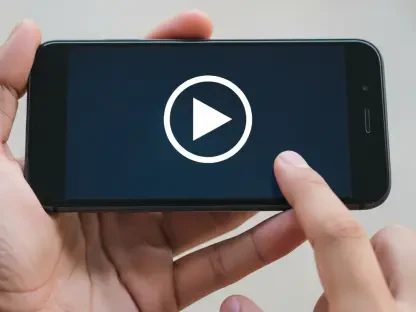Imagine scrolling through a social media feed, bombarded by a ceaseless stream of content, when suddenly a vibrant, fast-paced mobile game ad stops your thumb mid-swipe, sparking curiosity in just three seconds. In that fleeting moment, a tap feels almost instinctive, encapsulating the immense challenge and artistry of mobile advertising in 2025, where capturing attention in a hyper-competitive digital space is both a science and a necessity. With attention spans shrinking and user expectations soaring, mobile game ads must master the art of instant engagement to drive installs and conversions. This industry report delves into the strategies, science, and trends behind crafting ads that hook users in mere seconds, exploring how brands navigate a crowded landscape to stand out.
The Mobile Advertising Landscape: A Competitive Digital Arena
The mobile advertising industry in 2025 stands as a dynamic and fiercely contested battleground, fueled by exponential growth in smartphone usage and digital consumption. Billions of dollars are invested annually as brands vie for fleeting moments of user focus amid an overwhelming influx of content. Mobile gaming, a dominant force in this ecosystem, accounts for a significant share of ad spend, driven by its massive, engaged audience and the potential for high user retention. This sector’s rapid evolution reflects broader technological advancements, with sophisticated tools shaping how ads are created and delivered.
Key players, including tech giants and specialized mobile marketing firms, leverage cutting-edge innovations like AI-driven targeting to refine audience segmentation with unprecedented precision. Platforms such as Meta and TikTok have become central hubs for mobile game ads, offering vast reach and unique formats that cater to diverse demographics. These platforms not only amplify visibility but also set the tone for creative standards, pushing advertisers to adapt to fast-changing user behaviors and algorithmic preferences.
Beyond technology, the competitive nature of this arena demands constant innovation in content delivery. Advertisers must contend with the challenge of standing out in feeds saturated with rival promotions, where a single misstep can render an ad invisible. The integration of data analytics and machine learning further intensifies this race, enabling real-time optimization of campaigns to maximize impact. As the stakes continue to rise, understanding the nuances of this landscape becomes critical for any brand aiming to carve a niche in mobile gaming.
The Science of Attention in Mobile Ads
Understanding the Three-Second Window
In an era where digital content floods every screen, the human attention span has dwindled to a mere flicker, often shifting every few seconds. For mobile game ads, this translates to a critical three-second window to capture interest before a user scrolls past. This razor-thin timeframe dictates the entire approach to ad design, demanding an immediate impact that halts the endless swipe and sparks curiosity. Failing to engage within this brief moment risks losing potential players to the next piece of content in an unforgiving digital stream.
This urgency is rooted in the psychology of attention, which can be categorized into four distinct types: bottom-up, triggered by sudden stimuli like bold visuals or sharp sounds; top-down, driven by deliberate focus on relevant interests; emotional, sparked by feelings such as excitement or surprise; and cognitive, based on quick recognition of familiar patterns. Effective mobile ads strategically blend these elements to create an instant connection, whether through a striking image that grabs the eye or a relatable scenario that tugs at emotions. Mastering this mix within three seconds is the cornerstone of user engagement in a distracted world.
Data and Trends Shaping Attention Dynamics
Recent studies underscore the stark reality of declining attention spans, with research indicating that users now process content faster but retain less due to information overload. This cognitive burden, compounded by the stress of constant digital exposure, means that users are increasingly selective, filtering out anything that fails to resonate instantly. Mobile game advertisers must navigate this landscape by distilling complex messages into concise, impactful bursts that demand minimal mental effort from viewers.
Looking ahead, trends suggest that precision and adaptability will define market leaders in the coming years, particularly from 2025 to 2027. Brands that invest in understanding user psychology and tailoring content to specific moments of receptivity are poised to outperform those relying solely on hefty budgets. Data also points to a shift toward hyper-personalized ads, with algorithms predicting user preferences in real time to deliver relevant hooks. As cognitive load continues to shape digital habits, the ability to cut through the noise with clarity will separate successful campaigns from the clutter.
Challenges in Crafting Effective Mobile Game Ads
Creating a mobile game ad that stands out in 2025’s saturated digital environment is a daunting task, marked by the sheer volume of competing content. Users, bombarded by countless promotions daily, exhibit little patience for anything that fails to grab them instantly, often dismissing cluttered or uninspired designs without a second glance. This relentless pace leaves advertisers struggling to craft visuals and messages that break through the noise while maintaining relevance to a discerning audience.
Another hurdle lies in striking a balance between creativity and conversion objectives, as overly artistic approaches may dazzle but fail to drive action. Misleading hooks, while tempting for their shock value, often attract low-quality traffic—users who click out of curiosity but lack genuine interest in the game. Such tactics can inflate initial metrics but ultimately harm long-term performance, forcing advertisers to rethink how to align captivating content with authentic user intent in a meaningful way.
Adapting to platform-specific norms adds another layer of complexity, as each major platform enforces unique guidelines on format, duration, and style. An ad that thrives on TikTok’s fast-paced, trend-driven feed may flop on Meta if it doesn’t match the platform’s storytelling expectations. Navigating these differences requires not only technical know-how but also a deep understanding of user behavior across ecosystems. Overcoming these obstacles demands a meticulous approach to ensure ads resonate without alienating potential players.
Key Strategies for Designing High-Impact Ads
To hook users in just three seconds, mobile game ads must prioritize a powerful opening that conveys value instantly through a compelling visual or narrative trigger. This initial hook should clearly signal what the game offers, using bold contrasts or surprising elements to stop scrolling in its tracks. Whether it’s a dramatic gameplay snippet or a humorous scenario, the first frame sets the tone, ensuring users pause long enough to engage with the message.
Beyond the hook, visual clarity plays a pivotal role, especially on small mobile screens where every pixel counts. Designs must avoid clutter, focusing on essential elements that communicate the game’s appeal without overwhelming the viewer. Adopting a platform-native style further enhances effectiveness, blending seamlessly with the look and feel of the host environment to prevent the ad from feeling intrusive. This alignment fosters trust and familiarity, increasing the likelihood of sustained attention.
A complete engagement funnel is equally vital to convert fleeting interest into tangible results like installs or purchases. This funnel begins with the hook, transitions into a quick demonstration of the game’s core features, delivers an emotional payoff to build connection, and concludes with a clear call-to-action that guides users to the next step. By structuring ads as a cohesive journey rather than a standalone gimmick, advertisers can maximize impact and ensure that initial curiosity translates into measurable outcomes.
Future Directions in Mobile Game Advertising
As mobile game advertising evolves in 2025, emerging trends point to a preference for rapid, TikTok-inspired editing styles that prioritize quick cuts and dynamic pacing to match user expectations for snappy content. This shift reflects a broader move toward concise storytelling, where every second is optimized for engagement. Advertisers are increasingly adopting these techniques to mirror the fast-scrolling habits of younger demographics who dominate mobile gaming audiences.
A growing emphasis on quality over quantity also shapes the industry, with brands focusing on fewer, high-impact ads rather than flooding platforms with generic content. This approach aligns with user fatigue over repetitive promotions, encouraging deeper investment in polished creatives that leave lasting impressions. Additionally, potential disruptors like new social platforms and innovative ad formats are reshaping strategies, compelling advertisers to stay agile in response to shifting digital consumption patterns globally.
Evolving user behaviors further complicate the landscape, as privacy concerns and ad-blocking technologies challenge traditional targeting methods. Meanwhile, advancements in interactive ad formats, such as playable previews, offer fresh avenues to captivate audiences directly within the ad experience. Keeping pace with these changes requires a forward-thinking mindset, ensuring that mobile game ads remain relevant amid technological and cultural transformations on a worldwide scale.
Wrapping Up: Mastering the Three-Second Hook
Reflecting on the insights uncovered, it becomes evident that mastering the capture of attention within a three-second window has been a defining factor for mobile game advertising success in 2025. The blend of scientific understanding—leveraging different types of attention—and creative ingenuity has proven essential in cutting through the digital clutter. Challenges like platform diversity and user impatience have tested advertisers, yet strategic approaches focusing on clarity and emotional resonance have yielded impressive results.
Looking back, the industry has shifted markedly toward precision and adaptability, with data-driven personalization paving the way for more meaningful user interactions. For future progress, marketers are encouraged to deepen their focus on platform-specific tailoring, ensuring ads feel native and intuitive to each environment. Experimenting with emerging formats and staying attuned to global trends have also emerged as critical next steps to maintain a competitive edge. By prioritizing quality engagement over sheer volume, the path forward promises sustained growth and innovation in hooking users instantly.









